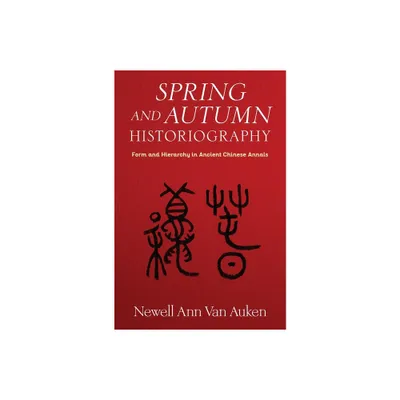Home
Spring and Autumn Historiography: Form Hierarchy Ancient Chinese Annals
Loading Inventory...
Barnes and Noble
Spring and Autumn Historiography: Form Hierarchy Ancient Chinese Annals
Current price: $65.00


Barnes and Noble
Spring and Autumn Historiography: Form Hierarchy Ancient Chinese Annals
Current price: $65.00
Loading Inventory...
Size: Hardcover
*Product Information may vary - to confirm product availability, pricing, and additional information please contact Barnes and Noble
The
Spring and Autumn
is an annals text composed of brief records covering the period 722–479 BCE and written from the perspective of the ancient Chinese state of Lu. A long neglected part of the Chinese canon, it is traditionally ascribed to Confucius, who is said to have embedded his evaluations of events within the text. However, the formulaic and impersonal records do not resemble the repository of moral judgments that they are alleged to be.
Driven by her discovery that the
is governed by a system of rules, Newell Ann Van Auken argues that Lu record-keepers—not a later editor—produced the formally regular core of the text. She demonstrates that the
employs formulaic phrasing and selective omission to encode the priorities of Lu and to communicate the relative importance of individuals, states, and events, and that many of its records are derived from diplomatic announcements received in Lu from regional states and the Zhou court. The
is fundamentally a document designed to enhance the prestige of Lu, and its records reveal a profound concern with relative rank, displaying an idealized hierarchy that positions the state of Lu and its rulers at the apex. By establishing the
as a genuine Bronze Age record, this book transforms our understanding of its significance and purpose, and also offers new approaches to the study of ancient annals in early China and elsewhere.
Spring and Autumn
is an annals text composed of brief records covering the period 722–479 BCE and written from the perspective of the ancient Chinese state of Lu. A long neglected part of the Chinese canon, it is traditionally ascribed to Confucius, who is said to have embedded his evaluations of events within the text. However, the formulaic and impersonal records do not resemble the repository of moral judgments that they are alleged to be.
Driven by her discovery that the
is governed by a system of rules, Newell Ann Van Auken argues that Lu record-keepers—not a later editor—produced the formally regular core of the text. She demonstrates that the
employs formulaic phrasing and selective omission to encode the priorities of Lu and to communicate the relative importance of individuals, states, and events, and that many of its records are derived from diplomatic announcements received in Lu from regional states and the Zhou court. The
is fundamentally a document designed to enhance the prestige of Lu, and its records reveal a profound concern with relative rank, displaying an idealized hierarchy that positions the state of Lu and its rulers at the apex. By establishing the
as a genuine Bronze Age record, this book transforms our understanding of its significance and purpose, and also offers new approaches to the study of ancient annals in early China and elsewhere.


















